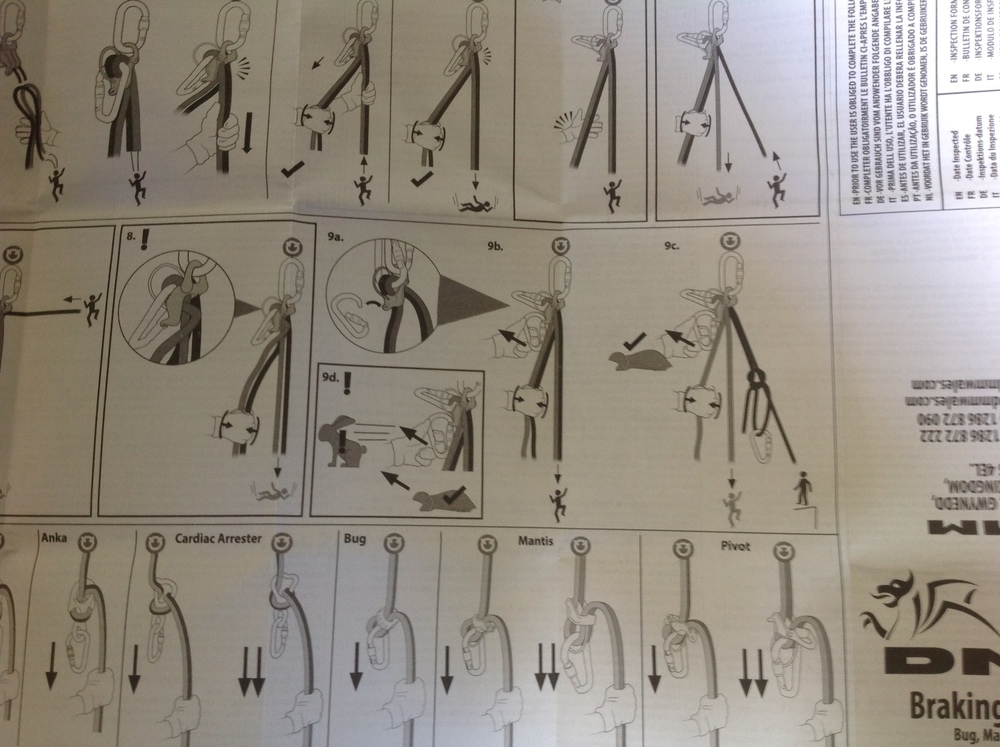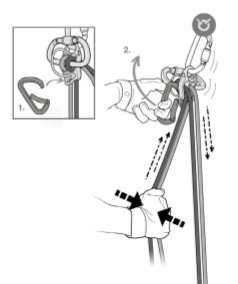Has anyone been dropped in guide mode when the device is levered by hand ?
|
|
Thanks Helen, what method were they using ? |
|
|
Serge, here are DMMs instructions for lowering. The text reads "Lowering: Diagrams 9a - d. Warning Lift carabiner gradually to avoid sudden release (Diagram 9d)."
The sling redirect imo is more problematic (needs to be backed up) because it enables you to use your body weight for levarage, putting much more force on the device in a hard to control manner. |
|
|
Serge Smirnov wrote: Thanks Helen, what method were they using ? be careful with this logic. there's never a reason to rush, as long as you're always baking up the break with a 3rd hand however you release the plate device is up to you. |
|
|
Serge Smirnov wrote: Thanks Helen, what method were they using ? He was using the "I think I remember how this is supposed to work????" method. Point is, this was set up by a conscientious and careful young climber when he was learning. I was only a few feet off of flat rock, and he was close enough for us to talk back and forth. He always worked through every bit of new rigging, thoroughly, in a scaled down, safe, venue. He still does. Doing this stuff with him was super fun, honestly, and I learned a lot that beginners usually don't see at all, from my very first day.But, how many newish climbers are truly sure of what they are doing, before hauling their totally inexperienced friends out? Friends who are so clueless about this thing we love, and respect, that they have no idea they should be afraid. Very, very, afraid. IMO, this is one of the ones that can really bite people, because it isn't a routine thing, lowering a second, and doesn't extrapolate from routine things either. You either practice enough you truly 'get it'....or perhaps not. Maybe try it, once, think you have it, good to go. Mess up....well, messy is the operative word. Just my two cents as a noob who wants to live long and prosper. I am very wary of "lowering in guide mode". I'll ascend the rope, if it comes to that. That, I control. I'm also very picky who I will trust to take my noobness up a multipitch. So far, so good, wonderful people all three times. Yeah. Three. Betcha you can't even remember when it was that new! We have no local multipitch, except one thing nearby, that involves fourth class I have no desire to mess with. Best, Helen |
|
|
Twice!!!! The last time by an off duty guide! |
|
|
Guy, to confirm - you were dropped when the belayer levered the device by hand, w/o using their body weight via a redirected sling ? |
|
|
The answer is a Munter Hitch. |
|
|
Munter hitch (or more accurately, an Italian Hitch, Mal!--do my people proud, brudda!) is one answer, for sure. For a long lower, though, you won't be psyched. |
|
|
p.s. all this is detailed with photos in the MGM. |
|
|
SethG wrote: No way man (supported by the fact that you switched to a Pivot). You have to really crank on a biner as a lever to be effective. I much prefer to use my weight, redirect, and flip the device, then I have the added benefit of control and a back-up. And because I'm proficient, the system takes seconds to rig. I haven't had the same affection for the Pivot. Ease of use, however, is a matter of opinion. I still contend, though, that if your second is going to be working a route, a Grigri is the best option by far. |
|
|
Parker Kempf wrote: https://www.youtube.com/watch?v=7vB7tMKLh-g Misleading to cite this video, in my opinion. First of all, the OP question is about levering by hand. The technique shown in the video is for cases when the climber is not weighting the rope (rare), and there no levering by hand is shown. Honestly I hate this video because it's confusing, and also, if someone did this while you were weighting the rope, you would be fuc&ed. It's basically a guide-trick to save time, by sending the client back down a pitch quickly, without having to change things over to a rappel. |
|
|
chris magness wrote: I switched to a Pivot because people on MP said it was easier to control the on/off, even though I'd never had a problem controlling the on/off. It was not because I'd ever had a problem releasing the autolock while it was loaded. |
|
|
This thread seems to be another example of what OP is describing. |
|
|
coppolillo wrote: https://rockandice.com/climbing-accidents/climber-dropped-when-lowered-in-autoblock-mode/ Worthy Companion to "Italian Hitch" use. The Guide Mode ThreadBetween The "Italian Hitch" post & the one quoted, Coppolillo has the meat of the subject well covered ~ Thanx for that! I am still happiest using a Sprung Stich plate(for everything: Rapping & Belaying w/ re-direct off the anchor, ascending with Klimb-hiest.) I got some disapproving looks so switched for the most part to a Reverso type device. . . I still get looks due to the Kong Robot that is always on my harness. |
|
|
Serge Smirnov wrote: To me, lowering using a carabiner-hand lever feels like lowering with a Grigri. I have not (yet) seen a recommendation to back up a Grigri lower with a friction hitch. Wondering if a guide mode device levered by a caraber has some subtle additional failure mode. See Petzl's instructions for lowering with a Grigri: petzl.com/US/en/Sport/Lower…; Note that they explicitly recommend clipping the brake strand to a locker above/behind the device, resulting in 2X 180-degree turns of the rope (one around the Grigri, one around the carabiner), like a tube device in the normal harness belay braking position. When levering a plaquette open the way you're asking about, the brake strand is exiting nearly parallel to the load strand, which is a much less powerful braking position. One option (of many) to improve this is clipping the brake strand back to a point in the anchor above the device, resulting in a more powerful braking action. Also note that for normal lowering (for example, after your leader finishes a single pitch climb), most of us probably use both hands on the brake strand. If one hand is levering the device open (in an autoblocking scenario), that only leaves 1 hand left for the brake, which probably explains the common practice of a third hand friction hitch on the brake strand during "guide mode" lowering scenarios. |
|
|
Thanks for the Grigri link Kyle - good to know, hadn't seen it. But there is a lot of friction between the 2 rope strands when lowering through a levered plaquette device. As people pointed out, it takes a lot of effort to get the rope moving at all. In this sense, the carabiner method is inherenty safer than a Grigri (or a nut tool) because one typically just doesn't have the strength to lever the device to a completely frictionless position with just a carabiner. |
|
|
coppolillo wrote: Munter hitch (or more accurately, an Italian Hitch, Mal!--do my people proud, brudda!) is one answer, for sure. For a long lower, though, you won't be psyched.Why would the Italian hitch be an issue for long lowers? |
|
|
Serge Smirnov wrote: I.e. WITHOUT the sling/redirect/body weight method. People have been dropped but that doesn’t mean you’ll drop someone. However, just because you haven’t dropped someone yet, doesn’t mean you never will. I mostly use(d) the “guide mode” on my Reverso when I was ... wait for it ... guiding!! A client/partner who will need to rest a lot and not want to watch me eat while we’re at the belay is the perfect time for the assisted blocking mode. That, and it’s by far the best way to belay 2 followers at once. I always used a munter on my harness because I was working and why not? Didn’t really need it but it does make it easier and faster because you don’t have to be as delicate. I rarely use my Reverso in that way anymore but will still replace it with a similar device. SMC spire looks good. That and the Pivot, which I have used, are smooth enough that I might not use a backup as often. Every situation is different though, be prepared. |
|
|
I have done large numbers of lowers and the last post says it well: |
|
|
As Rob see you mentioned above, the Load Strand Direct or "LSD" Is a very straightforward way of lowering your second, provided they can give you about 1 foot of slack for a second or two. |

 Continue with onX Maps
Continue with onX Maps Continue with Facebook
Continue with Facebook























